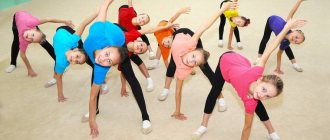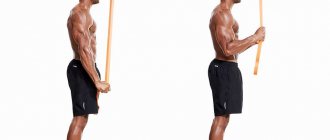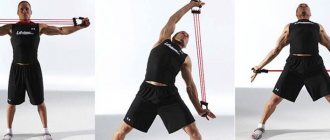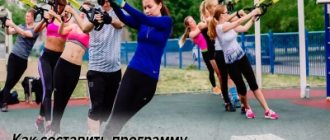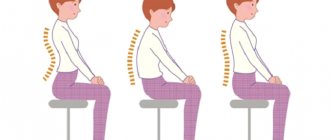© Prostock-studio — stock.adobe.com
Share:
What you need
- horizontal bar
Can't go to the gym regularly? Don't fall into despair! You can fully train without going far from home with the help of the simplest sports equipment - a horizontal bar. A well-designed horizontal bar training program for beginners allows you to work out almost all the muscles of the torso: latissimus dorsi, biceps, triceps, deltoids and abs.
The benefits of exercising on the horizontal bar
There are dozens of varieties of exercises on the horizontal bar: pull-ups in various variations, push-ups, hanging leg raises, power-ups and many others. Finding the ones that suit your purposes won’t be difficult. With the help of the complexes described in the article, you will gain muscle mass, become stronger and improve your relief. However, methodicality and consistency are important in everything, and training on the horizontal bar with your own weight is no exception.
In this article we will analyze several of the best training programs on the horizontal bar, answer the question of how to create an individual program, and give useful tips and recommendations.
Benefits of training
It is no coincidence that exercises on the horizontal bar and parallel bars form the basis of general physical training (GPP). Men are taught to practice on the horizontal bar from childhood: both at school and in any sports section. In the army and in physical education at the university, these exercises are also not ignored. How are they useful and what are their main advantages?
- Availability and prevalence. There are horizontal bars in every yard: you don’t have to waste time getting to the training place. In large cities there are more and more well-equipped workout areas with horizontal bars of different heights and widths, parallel bars, rings, ladders for grip training, ropes and other equipment. All this is free. You can do it even simpler - buy or make a horizontal bar yourself and play sports without leaving your home.
- Variety of the training process. If you think that training on the horizontal bar is limited to just pull-ups, you are deeply mistaken. Having a certain physical training, you can work out almost all the muscles of the torso on the horizontal bar.
- Safety. If you follow the correct exercise technique, the risk of injury is minimized. The rules are simple: during pull-ups and other pulling exercises, do not tilt your head back too much, do not round the thoracic spine, and do not make circular movements with your shoulders.
- Increased muscle mass and strength. On the horizontal bar it is easy to implement the principle of progression of loads, which will make you bigger and stronger. Also, training with your own weight strengthens ligaments and tendons, which increases strength potential.
- Save time. Training on the horizontal bar will not take much time. 25-30 minutes is enough to complete the entire planned amount of work.
Positive effect on the body
It has been proven that prolonged hanging on the horizontal bar without the use of wrist straps relieves hypertonicity in the spinal extensors, strengthens the grip, improves posture and reduces the risk of back injuries.
Continuous work with your own weight allows the muscles to overcome pain and a burning sensation in the muscles. Refusal comes much later. Over time, athletes adapt to such loads, and training on the horizontal bar is much easier.
Among other things, playing sports in the fresh air is much healthier for the body than in a stuffy gym. A higher oxygen content in the air promotes rapid recovery between approaches and improves the oxidation process of adipose tissue.
Contraindications
Not all athletes will benefit from training on the horizontal bar. It is widely believed that hanging on the horizontal bar has almost miraculous properties and helps with hernias and protrusions. Unfortunately, this is far from the case.
If you have such problems with the spine, you should not train on the horizontal bar at all, since a long time in an extended position can aggravate the situation.
Be sure to consult with a qualified physician before beginning full-scale exercise. Only he will competently answer the question of how to play sports and not harm your health.
It is also not recommended to exercise on horizontal bars for those who have recently had sprains or torn ligaments in their shoulders or elbows. Hanging for a long time will lead to pain, especially if your own weight is above average. You risk recurrence of the injury.
Types of push-ups
Dips are one of the most effective exercises for working pushing muscle groups. These include:
- Breast.
- Triceps.
- Front delts.
There are two options for performing this exercise:
- For the chest.
- For triceps.
As you might have guessed, the execution technique for these options is completely different. So, to work out the chest on the uneven bars, you must adhere to the following rules:
- When performing the negative phase, it is necessary to spread your elbows to the sides.
- You need to go as low as possible.
- At the lowest point you need to linger for 2-3 seconds. This is necessary in order to feel the tension of the pectoral muscles as much as possible.
- At the top point, you do not need to straighten your arms completely so that the triceps do not take part of the load.
- There is no need to lower your head. Your gaze should be directed forward.
To work out the triceps, you must adhere to other rules:
- When performing the negative phase, you need to move your elbows back.
- You need to lower yourself to such a level that your arms are bent at the elbows at a right angle.
- At the top point, you must fully straighten your arms. This will make your triceps work better.
- You need to stay in this position for 2-3 seconds. This will help you feel the maximum tension in your triceps.
What about the front delts? They come into play when performing any version of this exercise.
Pushing muscles love high-intensity training. Therefore, an indicator that you are doing everything right is a constant burning sensation in your muscles. We will rely on it when building training programs.
In addition to push-ups, there are other sports exercises on parallel bars. These include:
- Plank.
- Diagonal push-ups.
- Jumping with arms.
- Back push-ups.
Of course, they are not as effective as dips. However, they are very good for completing a workout. And if you feel like you want to diversify your training process, you can include them in your program.
Special programs
To train pushing muscle groups, only dips on uneven bars will not be enough. It is necessary to combine them with various options for push-ups from the floor. That is why we will introduce them into our training complex.
Breast program:
- Chest style dips - 3 sets.
- Push-ups with wide arms - 3 sets.
Triceps program:
- Dips with elbows pulled back - 3 sets.
- Push-ups with narrow arms - 3 sets.
Program for Beginners
The first thing beginners need to do is learn how to do pull-ups technically correctly. Pull-ups are performed not by the biceps and forearms, but by the latissimus dorsi muscles. This is the basis on which all other exercises are built. The easiest way to do this is to try to bring your shoulder blades together as you lift your body up. No need to swing.
The pulling movement itself should be performed not due to some kind of impulse, but due to compression of the latissimus dorsi muscles. It is quite difficult to feel this movement, and often it takes more than one month of training. But when you learn to do this, your back will begin to grow at an enviable speed. Another option is to use straps, they help to “turn off” your arms.
Before you start performing the complexes, you need to do a test - do pull-ups with a wide grip for the maximum number of times. If you manage to do more than 5, skip the first program and immediately proceed to the second. If you manage to do 1-4 times, start with a simple 4-week program to increase the number of pull-ups:
| Week 1 | |
| Number of approaches | Number of repetitions |
| Day 1 | |
| 5 | 1, 1, 1, 1, maximum |
| Day 2 | |
| 5 | 1, 1, 1, 1, maximum |
| Day 3 | |
| 5 | 1, 2, 1, 1, maximum |
| Week 2 | |
| Number of approaches | Number of repetitions |
| Day 1 | |
| 5 | 1, 2, 1, 1, maximum |
| Day 2 | |
| 5 | 2, 2, 2, 1, maximum |
| Day 3 | |
| 5 | 2, 2, 2, 2, maximum |
| Week 3 | |
| Number of approaches | Number of repetitions |
| Day 1 | |
| 5 | 2, 3, 2, 2, maximum |
| Day 2 | |
| 5 | 3, 4, 3, 3, maximum |
| Day 3 | |
| 5 | 3, 4, 3, 3, maximum |
| Week 4 | |
| Number of approaches | Number of repetitions |
| Day 1 | |
| 5 | 3, 4, 3, 3, maximum |
| Day 2 | |
| 5 | 4, 5, 4, 4, maximum |
| Day 3 | |
| 5 | 4, 5, 5, 5, maximum |
The horizontal bar training program for those who were able to perform more than 5 pull-ups is designed for 3 sessions per week. Other exercises have already been added here. Each workout is quite short, no more than 30 minutes.
| Monday | ||
| "Jumping" pull-ups | 3x10-15 | |
| Horizontal pull-ups on a low bar | 3x10-12 | |
| Wide grip pull-ups | 3x5-7 | |
| Hanging on the horizontal bar | 4xmaximum | |
| Wednesday | ||
| Hanging leg raises to the bar | 3x8-10 |
|
| "Janitors" | 3x6-8 | |
| Imitation of French press on a low bar | 4x10-15 | |
| Hanging on the horizontal bar | 4xmaximum | |
| Friday | ||
| "Jumping" pull-ups | 3x10-15 | |
| Head pull-ups | 3x5-7 | |
| Close-grip pull-ups | 3x4-6 | |
| Hanging on the horizontal bar | 4xmaximum | |
Once you can complete the entire amount of work without much effort, begin to slowly increase the number of repetitions and approaches. Also, from time to time, measure your progress separately in pull-ups, because this is the basis of all exercises on the horizontal bar. If you can easily and technically perform 15 reps, it's time to move on to heavier training for more experienced athletes.
Another great option for increasing the load is to use additional weights. A backpack filled with something heavy, such as sandbags or water bottles, works well here.
Program on the horizontal bar for gaining weight
If you are a fairly experienced athlete and have a good command of the technique of all basic exercises, then this weight training program on the horizontal bar is for you. By doing it, you will add muscle mass in your arms, back and shoulders.
The bar training program for gaining mass is built around multi-joint movements that involve several large muscle groups at once. The work is carried out in the repetition range from 8 to 15. Only three workouts per week, but rest between approaches should be minimal - this way you will increase blood flow to the working muscles, without which muscle growth is impossible.
| Monday | ||
| Wide grip pull-ups | 3x12 | |
| Two-handed force exit | 3x6-8 | |
| Parallel grip pull-ups | 3x8-10 | |
| Horizontal pull-ups on a low bar | 4x15 | |
| Wednesday | ||
| Head pull-ups | 4x10 | |
| Pull-ups | 4x12-15 | |
| Diagonal pull-ups | 3x8 | |
| One arm hang | 3xmaximum | |
| Friday | ||
| Close-grip pull-ups | 4x10-12 | |
| Imitation of French press on a low bar | 4x12-15 | |
| Straight leg raises to the bar | 3x12 | © Makatserchyk — stock.adobe.com |
| Hanging Knee Raises | 3x15 |
|
As you can see, in every workout we directly or indirectly load all the major muscles of the core. This approach to training does not lead to overtraining at all, since the amount of work is not as large as with a classic three-day split in the gym. The muscles have time to fully recover.
To maintain the intensity of the training process, try to rest as little as possible between working approaches - no more than one minute. If the specified amount of work is too small for you, add 1-2 sets to each exercise and increase the number of repetitions to 15. You can also use additional weights.
How to train on the horizontal bar and parallel bars
It is best to train three times a week, giving your muscles rest. Typically, pull-ups, dips, and muscle-ups are separated and done on different days. However, nothing prevents you, with the proper level of training, from pumping your entire body in one workout and even training every day.
Below you can see a simple and fairly common program designed to develop target muscles and increase strength.
An extremely important and mandatory element of our training is warm-up. Any five-minute complex will warm up your joints and ligaments and set them up for work. Usually the pre-workout complex is performed “from top to bottom”, that is, first we will deal with the neck, and then it will come to the hips and ankles. So:
Warm-up
- Neck. We press our chin to our chest and remain in this position for one or two seconds.
- We stretch our trapezius: to do this, you need to carefully grab your head and lower it down to your shoulder. Do this a couple of times in each direction, then rotate your neck a little.
- Warm up your pectoral muscles well: clasp your hands and pull them back, then lift them up.
- Back. Grab a support and lean back, straightening your legs - you should feel a stretch in your lats.
- Everyone knows exercises for the oblique abdominal muscles - these are the usual bending of the torso to the side.
- It’s more difficult with the triceps: we place the bent arm behind the head, place it slightly lower than the neck, and with the other hand we pull the elbow. Repeat in mirror for the other hand.
- Rotate your shoulders, knead them well.
- For your legs, you need to lunge forward and to the side, and also be sure to stretch your knee joints. Place your feet shoulder-width apart, shift your body weight to one side, squatting on your leg. Then stand up and repeat the movement in the other direction. Place your feet together, place your hands on your knees and rotate them - this will stretch your knee joints.
Training program
Let's look at the training program on the horizontal bar and uneven bars using the example of a 3-day training. By dividing the exercises into these groups, it is easier to distribute the load and ensure muscle recovery, and therefore growth. Day 1
- Wide grip pull-ups. In these exercises, it is better to try to perform the maximum number of repetitions in each approach. Try, for example, doing it 70 times per workout - this will be an excellent test for your muscles.
- Hanging leg raises are a great abdominal exercise, but they do put a lot of work on your forearms. So try to do 4 sets of 10-15 reps. At first, simply raise your knees to your chest. As you get stronger, you will move on to straight leg raises 90 degrees, and then to touching the top of the bar with your feet. A variety of abdominal exercises on the horizontal bar are described in the article.
- To finally finish off your back and arms, take the time to master one-arm pull-ups. This is a very advanced movement, but the sooner you start trying, the faster you will learn.
Day 2
- Triceps or chest style dips. Try to do the maximum number of times in four approaches.
- Raising legs with support on parallel bars. We get into the position for regular push-ups and try to make a “corner”, that is, holding straight legs at an angle of 90 degrees.
- Exercise for muscular endurance: we do push-ups, but after each repetition we move our hands closer to the end of the exercise. The task is to overcome the entire length of the bars and return to the starting point.
Day 3
- Reverse-grip pull-ups, or if you're strong enough, try learning how to power-up—this exercise will help develop your upper chest.
- This day is best spent studying various strength elements, such as lifting coups and muscle-ups.
If regular pull-ups and dips are too easy for you, hang extra weight on your belt or use a backpack, this will give a new impetus to muscle growth.
And most importantly, train hard and don’t skip classes, because only then will you be able to achieve the results you need.
Relief program
In terms of the strength component, the training program on the horizontal bar for relief is not too different from working on weight. In both cases we train in the medium rep range (8 to 15) and do similar exercises. This is the optimal amount not only for gaining weight, but also for maintaining it.
The main difference between the dialing and cutting modes is nutrition. It is this that determines whether an athlete will build muscle mass or burn excess fat. Also, while drying, you can add cardio in separate workouts: jogging, cycling, etc.
To increase calorie consumption during strength training, we will need some exercises from CrossFit:
| Monday | ||
| Burpee with force on the horizontal bar | 3x8-10 | |
| Close-grip pull-ups | 4x10-15 | |
| Imitation of French press on a low bar | 4x12-15 | |
| Straight leg raises to the bar | 3x12-15 | © Makatserchyk — stock.adobe.com |
| Wednesday | ||
| Wide grip pull-ups | 4x12-15 | |
| Pull-ups | 4x12-15 | |
| Parallel grip pull-ups | 4x15 | |
| “Windshield wipers” | 3x8-12 | |
| Friday | ||
| Two-arm strength exercises | 3x8-10 | |
| Wide grip pull-ups | 4x10-15 | |
| Imitation of French press on a low bar | 4x12-15 | |
| Hanging Corner | 3x60-90 sec |
|
To get more out of this program, make it a habit to pause at the point of peak contraction in your pull-ups (the top of the range). The muscles respond well to this technique, the back quickly becomes stiffer and lumpier. Work strictly according to your feelings. When your lats are most tense, squeeze your shoulder blades and try to lock them in place. If you do everything correctly, you will feel something like a slight cramp in the latissimus muscles. The main thing at this moment is not to put the load on your biceps and forearms.
If you want to increase the intensity of your bar workout while burning fat, do the same program, but in a circuit training format. This is done as follows: perform one set of 10-15 repetitions of each exercise without rest. This is one round. After each round we rest for two to four minutes. There should be 3-6 rounds in total.
To track the progression of loads, gradually increase the number of repetitions in the sets. For example, do 3 rounds of 10 reps each set. Then 11, then 12 reps... When you reach 15 reps, add one extra round and repeat all over again.
Workout for back and abdominal muscles
If your back muscles are severely delayed in development, then a horizontal bar training program for developing your back and abdominal muscles is exactly what you need. These are the best exercises for growing your back wider; nothing more effective has yet been invented. By adding a few variations to the classic wide-grip pull-up, you will work the entire array of back muscles.
You can also fully train your abs using a horizontal bar. Agree, doing monotonous crunches on the floor or in machines at different angles is boring. In such situations, hanging leg raises come to the rescue; there are a huge number of variations of this exercise.
There will be four workouts in total in a week, the first two are hard, the second two are easier. This way you will be less tired without compromising your progress.
| Monday | ||
| Wide grip pull-ups | 5x10-15 | |
| Parallel grip pull-ups | 3x10-12 | |
| Close-grip pull-ups | 3x10-12 | |
| Horizontal pull-ups on a low bar | 4x15-20 | |
| Tuesday | ||
| Straight leg raises to the bar | 3x15 | © Makatserchyk — stock.adobe.com |
| "Janitors" | 3x8-10 | |
| Alternate hanging leg raises | 3x10-12 | |
| Hanging Knee Raises | 3x10-12 | © Jacob Lund — stock.adobe.com |
| Friday | ||
| Horizontal pull-ups on a low bar | 4x12-15 | |
| Wide grip pull-ups | 3x8-10 | |
| Saturday | ||
| Hanging Leg Raises | 3x10 | © Makatserchyk — stock.adobe.com |
| Hanging Knee Raises | 3x10 | © Jacob Lund — stock.adobe.com |
The volume of work on Monday and Tuesday is almost twice as much as on Friday and Saturday. This is necessary to relieve the psyche and muscles from hard work. If you are able to do four hard workouts a week, no one forbids you to do this, but then you will have to pay much more attention to recovery.
Training program on parallel bars and horizontal bar No. 2
Monday (back and biceps):
- Wide grip pull-ups - 2 sets.
- Pull-ups with a narrow lower grip - 2 sets.
- Wide grip pull-ups - 2 sets.
- Australian pull-ups - 1 set.
Tuesday (chest and triceps):
- Triceps dips - 3 sets.
- Universal push-ups - 1 set.
- Chest push-ups with front plank - 3 sets.
Wednesday: rest.
Thursday (back and biceps):
- Narrow grip pull-ups - 3 sets.
- Australian pull-up - 3 sets.
- Wide grip pull-ups - 3 sets.
Friday (chest and biceps):
- Triceps dips - 2 sets.
- Triceps push-ups - 3 sets.
- Chest push-ups on uneven bars - 2 sets.
- Chest push-ups in 3 sets.
Saturday, Sunday: rest.
The number of exercises and approaches may vary depending on the strength training of the athlete.
Strength training program
If your goal is to increase strength, a strength training program on the horizontal bar will help you.
Exercises like plyometric pull-ups (lifting your hands off the bar and clapping them), two-arm power-ups, and weighted pull-ups will make you much stronger:
| Monday | ||
| Two-arm strength exercises | 5x6-8 | |
| Wide grip pull-ups with additional weights | 3x8-10 | |
| Reverse grip pull-ups with additional weights | 3x8-10 | |
| Wednesday | ||
| Imitation of French press on a low bar | 4x8-12 | |
| Horizontal pull-ups on a low bar | 4x15 | |
| “Windshield wipers” | 3x10 | |
| Straight leg raises to the bar | 3x10-12 | © Makatserchyk — stock.adobe.com |
| Friday | ||
| Two-arm strength exercises | 5x6-8 | |
| Pull-ups using a towel | 4x6-8 | |
| Plyometric pull-ups | 3x8-10 | |
| Parallel grip pull-ups with additional weights | 3x8-10 | |
In total, it is advisable to conduct three workouts per week, in each of which you need to specifically work on strength in a relatively small repetition range.
Training program on parallel bars and horizontal bar No. 1
The program lasts 4 days. Balance beam and horizontal bar in addition to push-ups and abdominal exercises (leg raises and crunches).
Perform 10 to 15 repetitions in one attempt.
Monday
- Next we move on to chest push-ups.
- Perform leg raises on the horizontal bar.
- Start with a pull-up on a straight bar.
- Then work your back. Perform pull-ups on the bar with a wide grip.
- Then perform leg raises on the parallel bars.
- Do push-ups from the floor. Spread your arms slightly wider than shoulder-width apart.
Tuesday
- Then do the max.
- Then rotate the legs in a lying position (bicycle).
- The first three exercises of the second day are push-ups. First, your hands are positioned shoulder-width apart from each other.
- In the third part, the hands are placed next to each other. You can put one hand on the other.
- And the last exercise is turns.
- Now let's move on to the abdominal muscles. First, we perform leg raises while lying on our back.
Thursday
- Then exercises are performed for the triceps (dip-ups). Your elbows are pointing back.
- Leg raises on the horizontal bar. Simplified exercise: bend your legs.
- First, strengthen your biceps by performing reverse-grip pull-ups.
- Then you need to do push-ups from the floor. The task becomes more difficult - do push-ups with your fists. Spread your arms shoulder-width apart.
- Then raise your legs on the uneven bar.
Friday
- Then do push-ups with your fists. Keep your elbows close to your body.
- Then perform leg raises while lying down.
- For the first three exercises on Friday, perform push-ups. First, place your hands shoulder-width apart.
- And in the third exercise, the hands are placed as close to each other as possible (or one hand on top of the other).
- And the last exercise of the training cycle is crunches.
- Finally, we work on the abdominal muscles. First we perform crunches with torso rotations.
Tips for training on the horizontal bar
If you've been following the above programs but haven't noticed any significant changes in your fitness, don't get discouraged. These guidelines will help you reach your full potential.
Technical nuances
- Keep an eye on your technique. When performing pull-ups on the bar, focus the load on the back muscles, not on the arms. To better feel the contraction and stretching of the latissimus muscles, use wrist straps. Try to lower your shoulders a little, this way you will “free up” the trapezius and rhomboid muscles, and your back will receive more load.
- If your grip is the weakest link in your chain, pay more attention to your hang on the bar. You can use additional weights by hanging a weight or disk on a chain from your belt. Another option is to use a towel. Hanging on it perfectly develops the strength of the forearms. You can also wrap a towel around the bar to make it wider - this will strengthen your hands and increase finger strength. It is recommended to use magnesium, this will make holding the horizontal bar much more comfortable, and your grip is unlikely to let you down.
- Extinguish the force of inertia. Do not deceive yourself - each repetition must be performed under control. They should all be “clean”; you shouldn’t squirm your whole body to pull yourself up. There is no point in this. It is better to do fewer repetitions, but technically correct, the benefits will be much greater.
- Try to maintain a consistent pace of exercise. This will make it easier to use the neuromuscular connection and focus on stretching and contracting the muscles. This applies to all exercises performed with your own weight. However, this does not mean that the faster the better.
- If you are still a beginner and the training program we have indicated is difficult for you, pay attention to practicing auxiliary exercises. Do back exercises on blocks in the gym - this way you will become stronger and pull-ups will be much easier. Another option is to use a partner's help. Let him push you up a little while doing pull-ups, thereby making the task easier. After some time, you will be able to safely do pull-ups on your own. The third option is to do partial pull-ups. Over time, you will understand the biomechanics of movement and will be able to easily overcome sticking points and perform pull-ups at full amplitude. The last option is pull-ups in a gravitron. This is an excellent machine that helps you do pull-ups using a counterweight, the resistance of which can be changed as your strength increases.
- Watch your diet. It is not enough for muscles to stimulate growth through strength training; they need resources for recovery and subsequent hypertrophy. Therefore, a calorie surplus, sufficient protein intake (about 2 g per kg of weight) and complex carbohydrates (from 4 g per kg) are necessary.
Types of grip when pulling up on a horizontal bar
- Straight grip. This is the classic grip that is taught in school physical education classes. Hands are fixed on the horizontal bar with palms facing away from you. When performing pull-ups, you use muscle groups: back, biceps, triceps, forearms and deltoids.
- Reverse grip. This grip is easier to perform than the previous one. To perform it correctly, you need to fix your hands on the crossbar, with your palms facing you. This way you can work your biceps and back muscles.
- Parallel grip. With this type of grip, one hand is placed on the horizontal bar with the palm facing away from you, the other with the palm towards you. This type of grip primarily works the lower latissimus dorsi muscles. And if you do full pull-ups, touching your chin to the bar, your biceps will also actively participate in the pull-ups.
- Wide grip. By doing pull-ups with a straight, wide grip, you are doing a great job of working the trapezius, upper lats, and teres muscles. When performing pull-ups behind your head, the lower part of the latissimus muscles is activated. This is an excellent exercise for gaining muscle mass on the horizontal bar. Use the following technique: grab the horizontal bar wider than your shoulders, your thumb should be on the side of your palm, do not wrap it around the horizontal bar. During the exercise, make sure that there is 90 degrees between the forearm and the horizontal bar. As you lift your body, touch the bar with your chest.
- Narrow grip. With a straight close grip, you work the lower lats, brachialis, and serratus anterior muscles. While a reverse grip will allow you to engage your biceps. Technique for performing the exercise: grab the horizontal bar; palms should almost touch each other; hang from the bar and arch your back. Cross your legs to prevent your body from swaying. Bending your arms, try to touch the horizontal bar with your chin. Moving in the opposite direction, do not jerk, continue to extend your arms to 180 degrees at the elbows.
- Medium grip. This type of grip is used like the previous one, except that your hands are placed on the horizontal bar at shoulder width, and you should touch the bar with your upper chest. Using a straight medium grip, you'll work your shoulders, triceps, biceps, forearm flexors, and back muscles. With a reverse grip, you engage your biceps and latissimus dorsi.

